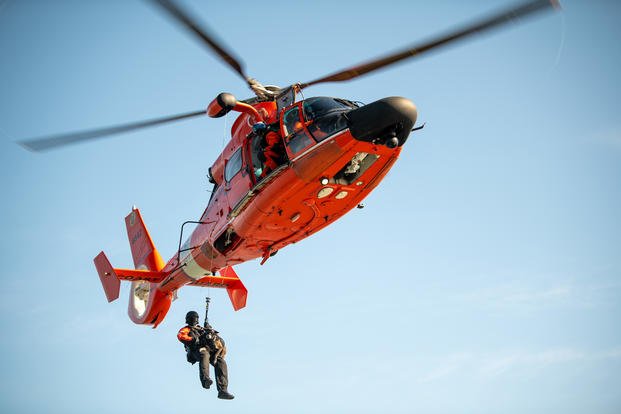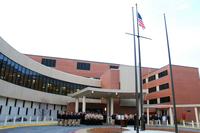The Coast Guard's short-range search-and-rescue helicopters are flying at 70% of their potential scheduled hours due to a parts shortage, a situation that could worsen as hurricane season approaches, the service's top officer told Congress on Wednesday.
Six Coast Guard MH-65 Dolphin helicopters are currently grounded, with four more expected to be out of circulation by June. That's roughly 10% of the fleet, Commandant Adm. Karl Schultz told the House Appropriations Committee's homeland security subcommittee April 28.
Hurricane season begins June 1 and runs through Nov. 30. Last year was the most active hurricane season since records were first taken in 1851, with 29 named storms, according to the National Oceanic and Atmospheric Administration.
Schultz said the service must "take immediate action" to transition its entire rotary wing force over to MH-60 Jayhawk helicopters.
"Aerospatiale Airbus, the parent company, stopped making the [MH-65 Dolphins] in 2018. We have the biggest fleet in the air -- we're at 98 -- and things like the gearbox, it's very difficult to get the parts," Schultz said.
Read Next: Pentagon’s Watchdog to Investigate Military’s Response to UFOs
The Coast Guard began flying MH-65 Dolphins in 1984. They are used for various missions, including search and rescue, drug interdiction, polar deployments, environmental protection and homeland security.
The service utilizes Dolphins across the U.S. and deploys them aboard cutters. Their bright orange airframes can be seen frequently over the skies of Washington, D.C., as crews conduct overflights of the National Capital Region.
The Coast Guard initiated a service life extension project for its MH-65s in 2018, with an aim to extend operations until 2035. The service awarded contracts for replacing the critical components of the aircraft, including canopy, center console, floor assembly, floor boards, side panels and other parts of the frame.
From fiscal 2019 through fiscal 2021, the Coast Guard budgeted $115 million for the component and avionics upgrades for the aircraft.
The most recent groundings, however, are largely due to the unavailability of parts, officials said. Maintainers have had to get creative, including issuing a contract last week seeking spare parts, and crafting some on their own.
The Coast Guard Aviation Logistics Center in Elizabeth City, North Carolina, is using 3D printing to make obsolete parts such as cooling ducts and antenna mounts, Schultz’s spokesman, Cmdr. Jay Guyer, said.
But the most challenging and needed parts -- the main gearbox and associated components -- are difficult to make via additive manufacturing and even harder to achieve Federal Aviation Administration certification, Guyer said.
"Industry just obtained its first-ever FAA certification for a 3D printed flight critical aircraft engine part less than nine months ago," Guyer explained. "The Coast Guard does not have the capability to employ additive manufacturing for flight critical or dynamic components.’’
According to Schultz, the Coast Guard expects to be involved with the Defense Department's future vertical lift plans. And with the expectation that new aircraft are 15 years down the road, the service plans to maintain its current fleet with a focus on the MH-60, a platform in use across the services.
The Coast Guard initiated a service life extension project for its MH-60 Jayhawks in 2017 to keep them flying through the mid-2030s. The service also has sought to increase the size of its Jayhawk fleet as the Dolphins get more difficult to maintain.
Since 2005, the service has converted seven former Navy SH-60 and four HH-60H Seahawks to Coast Guard MH-60s. It also uses parts from old Navy helicopters to maintain its MH-60 fleet. This year, it outfitted its first Jayhawk with ex-Navy folding rotors and tail booms so it can deploy on a cutter -- a task that until now has only been assigned to Dolphin aircraft.
Schultz said in a speech March 11 on the state of the Coast Guard that the new capability will allow the Jayhawk to deploy onboard national security cutters, offshore patrol cutters and the new polar icebreakers.
The service also is beginning to transition some MH-65 Dolphin units to MH-65 Jayhawks: Air Station Borinquen, Puerto Rico, will switch this year and Air Station New Orleans is slated to be next.
"We find that the Jayhawk has a robust domestic industrial base that can help buy down our operating risk in the decade ahead," Schultz said during his March 11 speech in San Diego.
During the hearing, Schultz could not discuss specifics of the Coast Guard's proposed fiscal 2022 budget, including funding for its rotary wing aircraft, because the administration has not released its complete budget proposal. The service received $12.84 billion in funding for fiscal 2021, $711 million more than President Trump’s original budget request.
He told lawmakers the service needs a 3% to 5% budget increase in the next five years to ensure readiness.
Representatives on the Homeland Security appropriations committee expressed support for the service and their dismay that it was not mentioned specifically in the Biden administration's budget preview, also known as the "skinny budget," released in April.
"Unfortunately, the preliminary budget document for fiscal year 2022 makes no mention of the Coast Guard. We can only glean from this that the request is unlikely to include any substance of enhancements for the service. I hope next month when we get the full budget request, this will not be the case," said Rep. Lucille Roybal-Allard, a California Democrat who chairs the subcommittee.
"I just want to make sure you're not selling yourself short here," Rep. John Rutherford, R-Florida, told Schultz, referring to the estimated 3% to 5% needed increase.
-- Patricia Kime can be reached at Patricia.Kime@Monster.com. Follow her on Twitter @patriciakime.
Related: The Coast Guard is Retiring Its Last Hamilton Class High-Endurance Cutter












